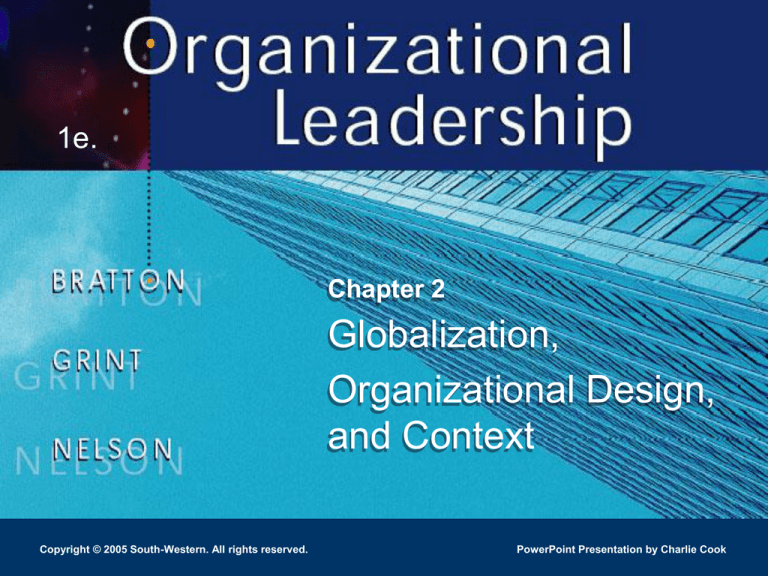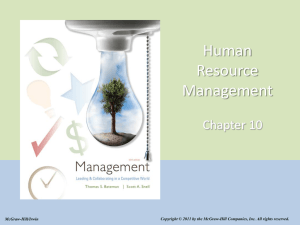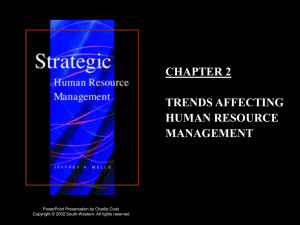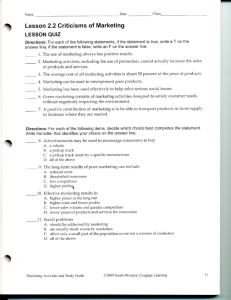
1e.
Chapter 2
Globalization,
Organizational Design,
and Context
Copyright © 2005 South-Western. All rights reserved.
PowerPoint Presentation by Charlie Cook
Chapter Objectives
After completing this chapter, you should be able to:
Identify the various contexts of leadership.
Understand the implications of these contexts for
leader–follower relationships.
Copyright © 2005 South-Western. All rights reserved.
2–2
An Integrative Framework
• An integrative, or “open,” model for examining
leader– follower relations that is divided into four
contextual components.
External context: environmental forces.
Organizational context: processes for converting
inputs into outputs within a cultural and human
resource management milieu.
Evaluative context: assessment of organizational
processes.
Feedback: a loop flowing back from evaluation into
the organization and hence into the environment.
Copyright © 2005 South-Western. All rights reserved.
2–3
An Integrated Framework for the External, Organizational,
and Evaluative Contexts of Leadership
Figure 2.1
Copyright © 2005 South-Western. All rights reserved.
2–4
The External Context
• Economic Context
Globalization (“disorganized capitalism”)
Reduced trade barriers, more global capital flows,
declining transportation costs, portable new
technologies, and integrated financial markets
Multinational companies (MNCs)
World-wide distribution of human and capital
assets for competitive advantage
Labor market flexibility
“Core” or “peripheral” workers
Copyright © 2005 South-Western. All rights reserved.
2–5
The External Context (cont’d)
• Technological Change
Advanced microprocessor-based technology (MBT)
that radically changes work processes.
Conventional technical change—new machinery that
does not incorporate microelectronic technology.
Organizational (structural) change involving in work
organization (e.g., self-managed teams) or job design
but not new machinery.
Copyright © 2005 South-Western. All rights reserved.
2–6
The External Context (cont’d)
• Political Context
General economic management
Supply-side
economics
Deregulation
Labor law reform and human resource management
Pro-individualistic
versus pro-collective regulations
Current and future quality of the natural environment
Asymmetrical
Kyoto
worldwide environmental destruction
Protocol on Climate Change
Copyright © 2005 South-Western. All rights reserved.
2–7
The External Context (cont’d)
• Social Forces
Changing workforce demographics
An
aging workforce in Western economies
Increasing social and cultural diversity
Class,
ethnicity, and gender
Language
Religion
and customs
and philosophy
Value
systems and attitudes toward work (work-life
balance)
Copyright © 2005 South-Western. All rights reserved.
2–8
Reflective Question ▼
• Look at Figure 2.1.
What recent external events have impacted your
workplace, the workplace in which a member of
your family is employed, or a workplace you have
studied.
How has the management responded to such
contextual changes? (For example, has it
introduced a new business strategy or new
methods of working?)
Copyright © 2005 South-Western. All rights reserved.
2–9
The Organizational Context
• The Strategy
A pattern of activity that top leaders perform over time
to achieve organizational performance goals.
Corporate,
business, and functional
Strategic leadership: the ability to articulate a vision
for the organization and to motivate followers to
support that vision.
Strategic formulation: involves senior leaders’
evaluating strategic factors and making strategic
choices that guide the organization to meet its goals.
Copyright © 2005 South-Western. All rights reserved.
2–10
The Organizational Context (cont’d)
• Strategies based on differentiation require:
Flexible followers, able to quickly and easily cross
over job boundaries.
The creation and maintenance of a required
knowledge base.
An appropriate corporate culture, which encourages
commitment to organizational goals.
A strategy and planning function within human
resource management that aims to mesh strategic
needs with operational requirements.
Copyright © 2005 South-Western. All rights reserved.
2–11
View CD
• Go to the CD-ROM and work through the
Organizational Design and Leadership
section.
How do the practitioners address how their
businesses are changing?
What contextual factors do they focus on?
Explain the links among the market conditions
faced by the firms.
How useful is the concept of strategic choice in
explaining management actions in these firms?
Copyright © 2005 South-Western. All rights reserved.
2–12
The Organizational Context (cont’d)
• The Organizational Structure
The manner in which an organization divides its
specific work activities and achieves coordination
among these activities.
Division of labor (dimensions)
The horizontal dimension involves grouping work
activities into subunits, or departments, and then
into jobs (specialization of the workforce).
The vertical dimension is concerned with
apportioning authority for planning, decision
making, and monitoring.
Copyright © 2005 South-Western. All rights reserved.
2–13
The Horizontal and Vertical Dimensions of
Division of Labor in a Manufacturing Firm
Figure 2.2
Copyright © 2005 South-Western. All rights reserved.
2–14
The Organizational Context (cont’d)
• Structural Components
Complexity: a measure of the degree of differentiation
within the organization, levels of hierarchy, and the
number of geographical locations of work units.
Horizontal complexity: the division of tasks
Specialization
and departmentation
Vertical complexity: levels of hierarchy
Flat
and tall organizations
Spans
of control
Copyright © 2005 South-Western. All rights reserved.
2–15
The Organizational Context (cont’d)
• Structural Components (cont’d)
Formalization: the degree of standardization of work
and jobs within the organization is defined and
controlled by rules.
Centralization: the degree to which decision making is
concentrated at a single point in the organization.
Decentralization
and autonomy
Centralization and control
Copyright © 2005 South-Western. All rights reserved.
2–16
Models of Organizational Structure
• Mechanistic
• Organic
High complexity
Low complexity
High formalization
(bureaucratic)
Low formalization
High centralization and
formal coordination
Downward vertical
communications
Maximizes efficiency and
productivity
Copyright © 2005 South-Western. All rights reserved.
Low centralization and
informal coordination
Participative decision
making
Horizontal and vertical
communications
Maximizes adaptability
and flexibility
2–17
Mintzberg’s Five Core Parts of a Work Organization
Source: Based on Mintzberg, H. (1979). The Structuring of Organizations. Englewood
Cliffs, NJ: Prentice Hall, pp. 215–297; Mintzberg, H. (1981). “Organization Design:
Fashion or Fit?” Harvard Business Review 59, January–February, pp. 103–116.
Copyright © 2005 South-Western. All rights reserved.
Figure 2.3
2–18
A Functional Configuration in
an Engineering Company
Source: Bratton J., and Gold, J. (2003). Human
Resource Management: Theory and Practice, 3rd ed.
Basingstroke, UK: Palgrave Macmillan.
Copyright © 2005 South-Western. All rights reserved.
Figure 2.4
2–19
A Product Configuration
in an Auto Company
Source: Bratton J., and Gold, J. (2003). Human Resource Management:
Theory and Practice, 3rd ed. Basingstroke, UK: Palgrave Macmillan.
Copyright © 2005 South-Western. All rights reserved.
Figure 2.5
2–20
A Matrix Configuration in
an Engineering Company
Source: Bratton J., and Gold, J. (2003). Human Resource Management:
Theory and Practice, 3rd ed. Basingstroke, UK: Palgrave Macmillan.
Copyright © 2005 South-Western. All rights reserved.
Figure 2.6
2–21
Business Process Reengineering (BPR)
• Changing how an organization relates to its
value-adding operational work.
Employees are seen as a valuable asset, capable of
serving the customer without command and control
leadership.
The firm develops a market-driven focus on the
relationship between buyer and seller of services or
goods, rather than the relationship between employer
and employee.
Copyright © 2005 South-Western. All rights reserved.
2–22
Traditional Versus Reengineered
Organizational Designs
Table 2.1
Copyright © 2005 South-Western. All rights reserved.
2–23
Reflective Question ▼
• Go to the following Web sites:
Center for the Study of Work Teams
http://www.workteams.unt.edu
DaimlerChrysler AG
http://www.daimlerchrysler.com
Canadian Auto Workers Union
http://www.caw.ca
• Why have these organizations introduced teams?
• Do teams always improve organizational
performance?
• Why are trade unions skeptical of work teams?
• How have teams affected organizational structures
and leadership styles?
Copyright © 2005 South-Western. All rights reserved.
2–24
Technology and Structure
• Production Technology
(Woodward)
• Types of Technology
(Perrow)
Unit production
(customized output)
Routine
(few exceptions)
Mass production
(standardized output)
Engineering
(many exceptions)
Continuous-process
production
(flow output)
Craft
(limited exceptions)
Copyright © 2005 South-Western. All rights reserved.
Nonroutine
(many difficult
exceptions)
2–25
Technology and Leadership
• The Contingency Approach
Suggests a situational relationship between types of
technology and organizational structure and
leadership style.
• Labor Process Theory
Considers economic and political interests (capital
accumulation) that lie behind technological change.
New technology “deskills” work in order to increase
management control over the labor process.
Critics countered with the suggestion of a strategy
of “responsible autonomy.”
Copyright © 2005 South-Western. All rights reserved.
2–26
The Concept of Strategic Choice
• Strategic Choice
Emphasizes the importance of managerial choice in
decisions about the implementation of technology.
Can be considered a political process in the exercise
of a power leader’s prerogative to make decisions.
Suggests that dominant coalitions are not necessarily
the holders of formal power within the organization.
Effective leaders serve as “creative mediators”;
allowing followers to modify the strategic decisions
made by the leaders.
Copyright © 2005 South-Western. All rights reserved.
2–27
People and the Leadership Process
• Individual differences can affect how followers
behave and relate both to other followers in the
workplace and to leaders:
Personal attributes (e.g., age, education, abilities, and
gender)
Attitudes and values about work
Social needs and preferences, experience, and
expectations
Cultural background
Copyright © 2005 South-Western. All rights reserved.
2–28
Organizational Culture and Leadership
• Culture
Is the social processes, bonds, underlying
assumptions, belief systems, espoused values,
norms, language, behavioral rituals, and myths that
uniquely identify an organization.
Is neither natural nor fixed; rather it is created through
socialization and learning.
Generates commitment and enthusiasm among
followers by making them feel that they are part of a
“family” and participants in a worthwhile venture.
Copyright © 2005 South-Western. All rights reserved.
2–29
Reflective Question ▼
• Think about an organization where you have
worked or studied.
Can you identify a set of characteristics that
describe its culture?
If its leaders sought to have a paradigm shift to a
culture characterized as innovative, what might
its socialization program look like?
Is socialization equivalent to brainwashing?
Copyright © 2005 South-Western. All rights reserved.
2–30
Human Resource Management (HRM)
and Leadership
• Human Resource Management
Is the body of knowledge and techniques associated
with regulating followers’ behavior.
Helps leaders meet organizational objectives and
resolve conflict stemming from the tension inherent in
the employment relationship.
Involves fostering desired forms of follower behaviors
related (fitted) to accomplishing aspects of the
business strategy.
Copyright © 2005 South-Western. All rights reserved.
2–31
The Evaluative Context
• Questioning Leadership
Does leadership really matter?
Do certain leadership activities actually lead to highperformance organizations?
• Measuring Leadership’s Effects on Outputs
Operating performance
Units
produced, quality, and sales
Financial performance
Return
on investment, market share, profits, and
stock price
Copyright © 2005 South-Western. All rights reserved.
2–32






